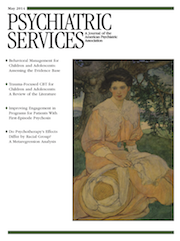Abstract
Objectives
This review examined rates and definitions of disengagement among services for first-episode psychosis (FEP) and identified the most relevant demographic and clinical predictors of disengagement.
Methods
A comprehensive search for and review of published studies that reported rates and predictors of disengagement within FEP services were conducted. The databases PubMed (1966–2012) and PsycINFO (1882–2012) were searched. Relevant terms were used to search the Internet and the reference sections of relevant papers for other pertinent studies. Independent searches for recent publications by leading researchers in the field were also conducted.
Results
Ten articles were included in the review. There was a lack of consensus on a clear definition of engagement and disengagement. However, despite differences in definitions and study settings, the evidence reviewed indicates that approximately 30% of individuals with FEP disengage from services. Variables that were consistently found to exert an influence on disengagement across studies were duration of untreated psychosis, symptom severity at baseline, insight, substance abuse and dependence, and involvement of a family member.
Conclusions
Given the importance of continuity of care for FEP, there is a need for a clearly defined and agreed measurement of service engagement and disengagement across FEP services. In particular, those who enter an FEP program without family involvement and support as well as those who maintain persistent substance abuse are at higher risk of disengagement. Early identification of such individuals and the development of approaches to reduce risk of service disengagement are likely to increase the effectiveness of these services.



